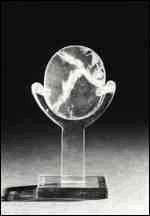Oldest Optical Device? - The Nimrud Lens
Jack Kramer
Who really invented lenses? It is generally held that a Dutch spectacle maker, Hans Lippershey, invented the telescope in 1608. But the origin of the lens itself is shrouded in mystery. In 1850, archeologist John Layard discovered what looks to be a lens at a site he was excavating at the palace of Nimrud in what is now Iraq. So could the first lens date to the ancient Assyrians? That would make lenses about 3000 years older than had been thought. According to Professor Giovanni Pettinato of the University of Rome, this rock crystal "lens", on display in the British museum, could explain why the ancient Assyrians knew so much about astronomy.

When Layard returned to England, he showed the artifact to physicist David Brewer who thought it could have been used as a magnifying glass or to concentrate the Sun's rays. As a magnifying glass, it could have been useful to Assyrian craftsman who made intricate seals and minuscule texts on clay tablets using a wedge-shaped script.
Not everyone agrees. Other experts on Assyrian archaeology say that the lens is of such low quality that it would have been a poor aid to vision. Even experts who agree that this could indeed be a lens say it's unlikely that this could have been part of what we know as a telescope.
Professor Pettinato counters by asking how the ancient Assyrians could regard the planet Saturn as a god surrounded by a ring of serpents? Might they have seen Saturn's rings through a "telescope" and interpreted them as serpents? Other experts remain unconvinced, pointing out that the Assyrians commonly used the serpent symbol in many places. They add that nowhere is such a device mentioned in their astronomical writings. Moreover, Galileo had a true telescope with which he was able to see many features on heavenly bodies, yet he was never able to identify the rings of Saturn as distinct rings; the planet appeared to him simply as a curious object with two lobes.
To our knowledge, Galileo was the first to turn a telescope toward the sky, although this device had already been in wide use for military and commercial purposes. If the Nimrud lens had been used as part of a crude telescope, then it's a case of a device having been invented and then forgotten.
But this artifact from Nimrud is not totally unique in the ancient world. Another artifact that appears to be a lens dating from roughly the 5th century BC was found in a cave on Mount Ida on Crete. It is more powerful and of better quality than the Nimrud lens. Also, the Roman writers Pliny and Seneca both referred to a lens used by an engraver in Pompeii.
It could be that the science of optics is a lot older than we have believed. But the Nimrud crystal could just as well have been an item of jewelry or an amulet. And, yes, it may even have been used as a lens. Without conclusive evidence, no one really knows.
Ref: BBC News Science Editor Dr. David Whitehouse
Published in the September 2002 issue of the NightTimes




